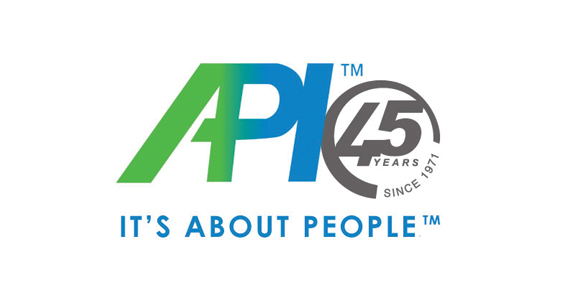Since the anniversary of our founding in July, the team at Aviation Personnel International (API) has been marveling at the fact that we’ve been serving the business aviation industry for an amazing 45 years!
That milestone has given us pause for a little reflection.
If we can claim the experience of 45 years as a learning process, one thing we know is how important a decision to hire someone for an aviation organization is.
After all, the candidate must be many things: technically proficient, safety-minded, highly experienced and, last but not least, well-equipped to live a different lifestyle than that required of other industries.
Working in business aviation is not for everyone, as we well know, and that’s why hiring managers have turned to API consistently through the years, to help them find the best possible cultural fit for their organizations.
Growth and Change
As we celebrate our 45th year in business, exclusively serving the business aviation industry, a lot has changed.
Following are some of the more notable developments we’ve observed (in no particular order of importance):
- When API got its start, in 1971, flight departments ran themselves and carried their own checkbooks. There were virtually no questions asked and little oversight from corporate. As you can imagine, there also was scant technology to help corporate keep tabs on the flight team at the airport hangar. What’s more, there were many fewer HR policies and much less financial scrutiny. Procurement departments were not involving themselves in aviation. We didn’t have Sarbanes-Oxley nor all of the 10Ks that are now required for shareholders.
- Up until 10 or 15 years ago, a business aircraft was used to get executives from point A to point B, but, it was a much more glamorous experience—often considered a “perk.” Nowadays, flying privately is much more about a safe and secure means of giving passengers time to be more productive while they’re in the air. Flying is a competitive tool that enables executives to meet customers, make deals quickly and/or reach multiple remote locations within one day.
- The corporate flight department is no longer viewed as the “royal barge” at the hangar. We’ve seen corporations rely less on cabin attendants and, instead, some corporations have transformed the role into flight technicians who have a dual function: customer service and maintenance. We’ve also seen companies eliminate alcohol from many flights and serve box lunches instead of more elaborate “white tablecloth” meals.
- Back in the day, a trip to Europe—and particularly Asia—required much more planning; it was a far longer process of preparation. International trip planning has come a long way in 45 years, as has technology, which we wrote about in this blog, Managing the Customer Demand for BizAv Inflight Connectivity.
- One major change that we’ve seen in the past few decades is corporate oversight of flights and flight activity. No longer does an aviation department only report directly to the CEO or Chairman. Now it’s much more common for the aviation organization to report to an executive who may not even be on the Senior Leadership team.
- We’re seeing flight departments that have been around for multiple decades merging with other companies. They’re also choosing “supplemental lift” partners with charter and fractional aircraft operators. And some are outsourcing to aircraft management companies.
- There’s a bigger emphasis on aviation leaders and pilots having a college degree and bringing more business skills to leadership roles. It’s very common for aviation directors to now have MBAs and CAM certifications; and they’re not flying as much as they’re managing a business within a business. These high-level professionals are working more and more with their partners at headquarters, developing fleet plans and making strategic decisions. They’re also required to recruit a diverse team and help them grow.
- We’re seeing a new “WIIFM” culture with aviation employees. No longer do people remain employed with one company for their entire career. It’s often the case that people move every two to five years, which is why finding the right cultural fit has become so important. Attracting new talent and rewarding them appropriately have become more difficult. Aviation departments need to find new ways to keep their team members feeling valued via development opportunities, cross-functional training and the opportunity to grow into a new role.
- Diversity is a much bigger concern, especially from an HR standpoint. More women and other, diverse candidates are in the market, but it’s still quite a low percentage overall. I recall a conversation with several of the “greatest generation” who said that, in their day, they could hire anyone they wanted, and if they only wanted to hire married white men, that was accepted. Now, as we all know, our flight departments are expanding their hiring horizons, and welcoming people of all genders, races, ethnicities and sexual orientations.
Whew. That’s a lot of evolution! Yet, over the past four and a half decades, one thing that I can tell you that’s never wavered: Business aviation is not about planes, “It’s about people™.”
Here at API, it’s been our privilege to serve this industry we dearly love. And, even after 45 years, it remains exciting, challenging, unpredictable and always worthwhile.
During this time, we have been privileged to work with thousands of aviation professionals, and honored to support some of the biggest brands in business, as well as some of the most exclusive private families. The API team knows that what we do impacts people’s lives, and we embrace that responsibility with some reverence.
And, we’d be remiss if we didn’t dedicate this year, and this milestone, to our founder, Janice K. Barden, who was an aviation pioneer from Day 1.
Your Turn . . .
We’ve outlined a few people-related changes we’ve observed in the business aviation industry over the past few decades. What changes have you witnessed? Please share in the comments below.

